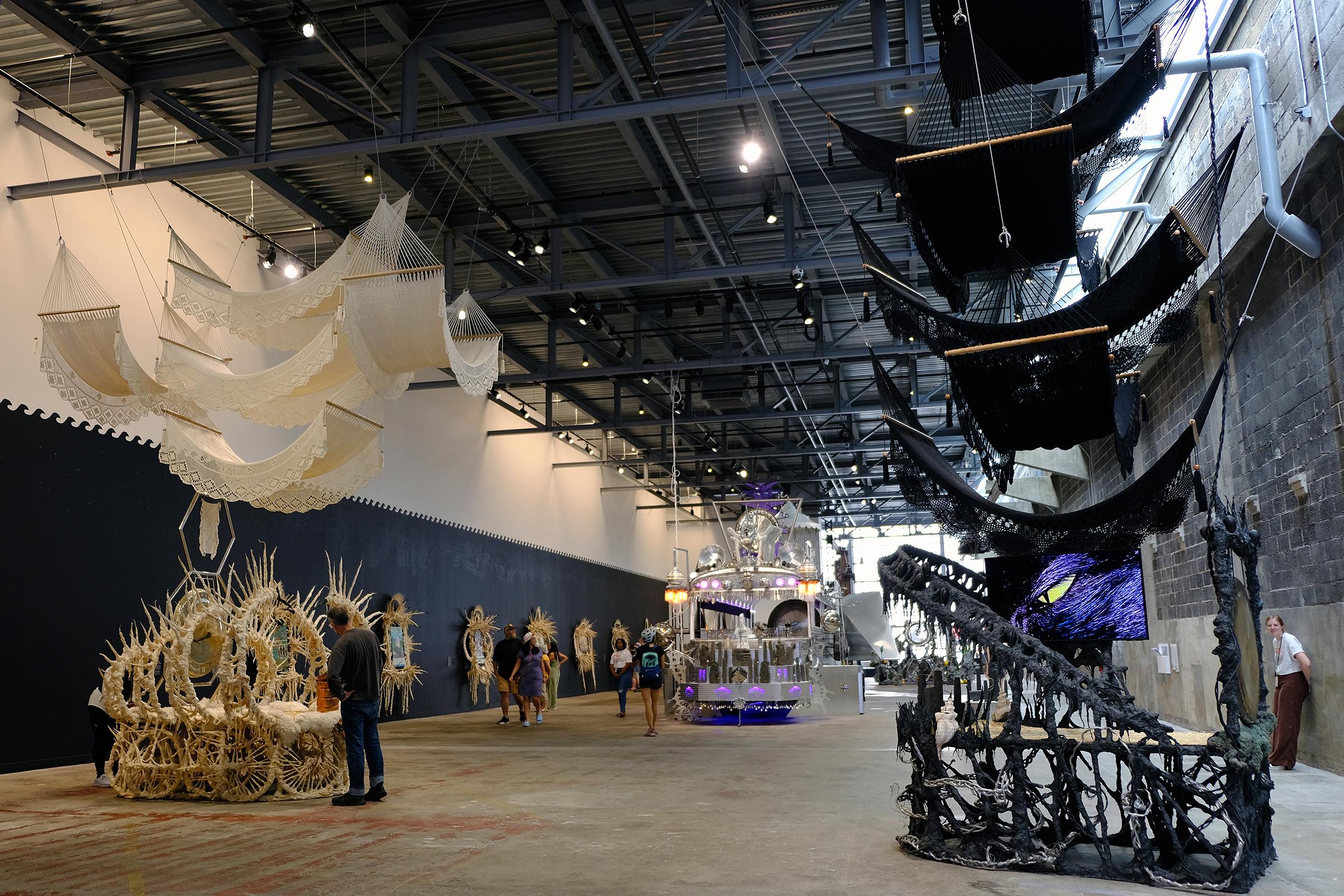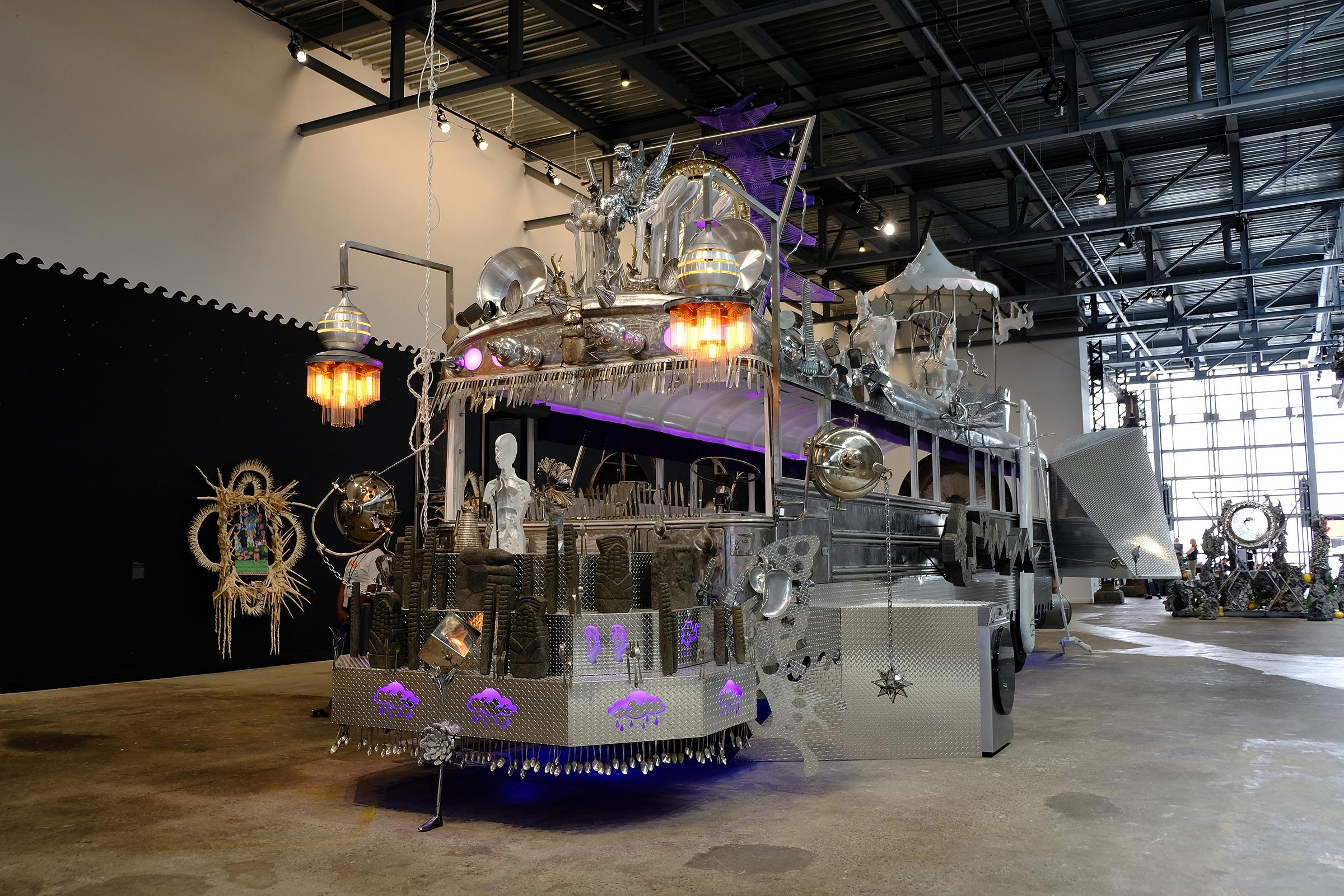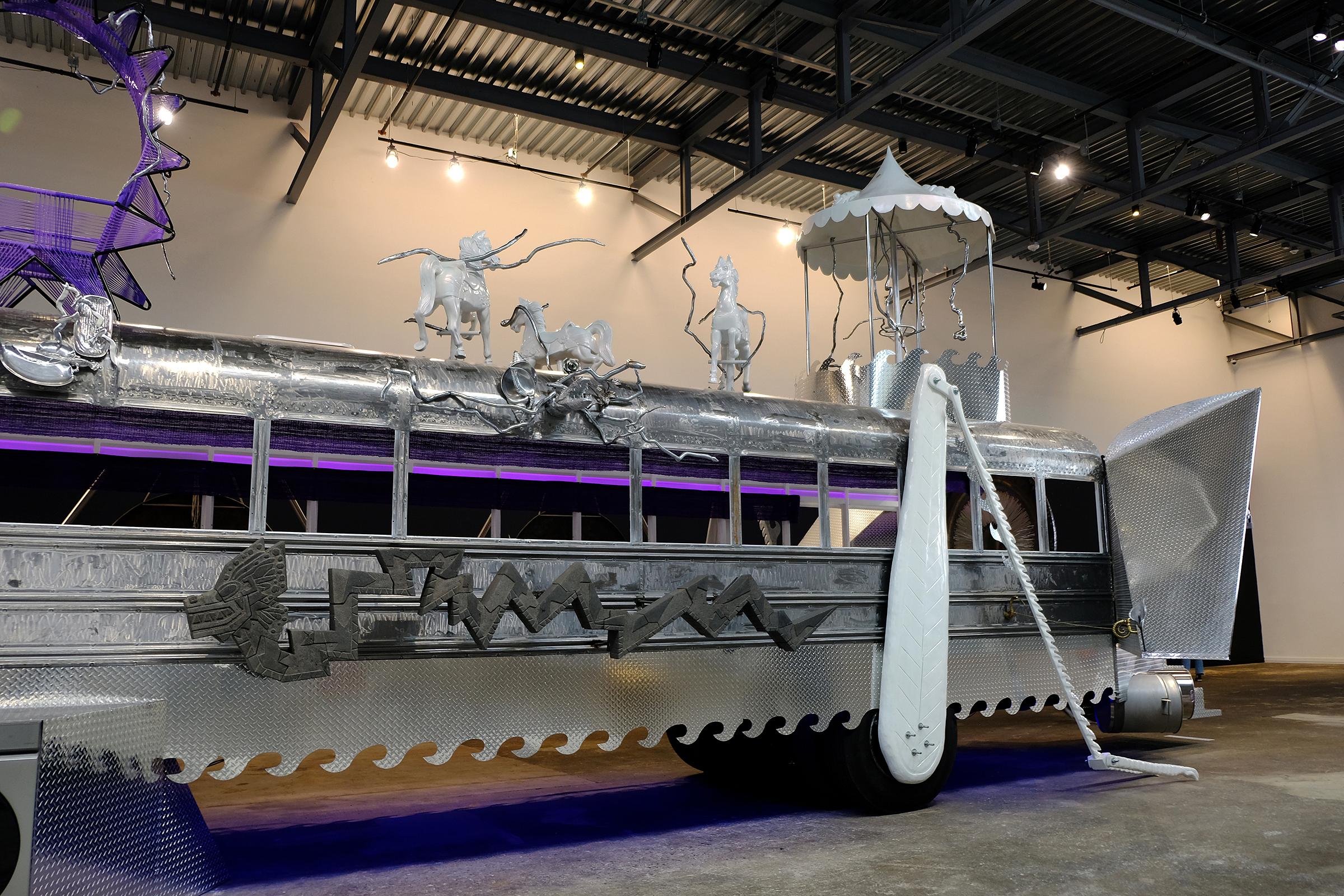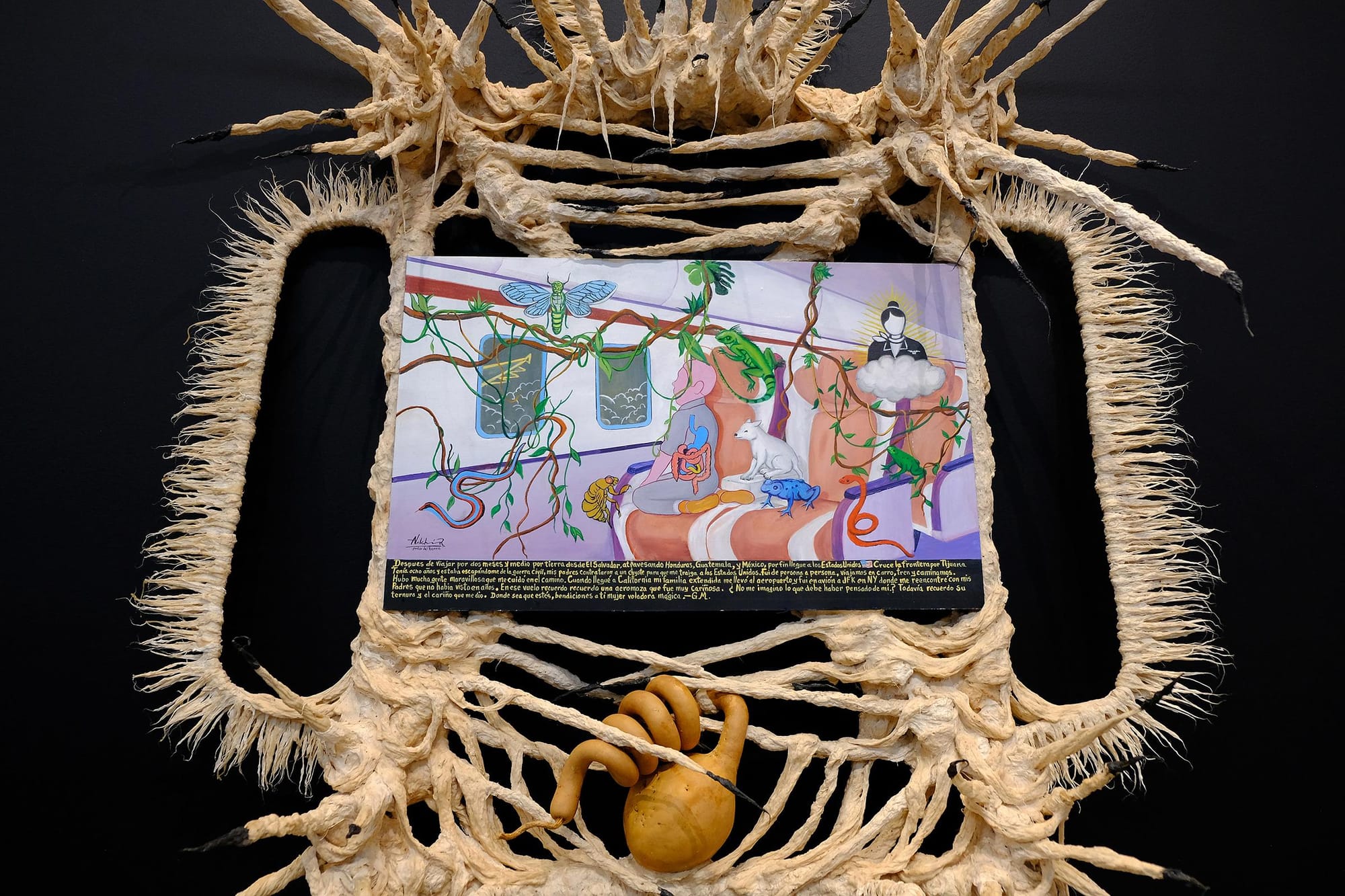Our experience of art doesn’t solely consist of the impression we get in the moment as we stand in front of a painting or sit in the audience of a performance. It’s also infused with all of the prior experiences, traumas, and memories we carry with us everywhere; they continue to reverberate through our mind and inform the way we see the world well after we’ve left a museum or theater.
I was acutely aware of this on Saturday as I experienced this year’s Institute of Contemporary Art (ICA) Watershed exhibition, “Guadalupe Maravilla: Mariposa Relámpago,” surrounded by all the sights and sounds of this summer’s Watershed Block Party.
The Watershed is a formerly condemned copper pipe factory which is now the Institute of Contemporary Arts’s annex building in East Boston, which is open during summer months. I was surprised to find online that the Watershed is always free and accessible through public transit, although it’s required to reserve a timed ticket if you’re taking the water taxi from the ICA’s main location in the Seaport.
My experience this Saturday began by speeding across Boston Harbor. The wind was pleasantly cool. I was so close to the water I could nearly touch it. Sailboats and the Boston skyline passed me by, and Bob Marley’s “Three Little Birds” blasted out of the boat’s boombox. The short trip across the water was as breezy and delightful as I’d hoped it’d be, if short but sweet (engine on to engine off took us exactly 10 minutes).
There were so many delightful colors, graffiti walls, and interesting things happening all around me upon docking that it was momentarily hard to tell which building I was supposed to be heading to, but I quickly found the Watershed thanks to a crowd gathered around a capoeira troupe dancing outside the building — part of the Block Party’s entertainment for the day, which also included multiple other performances, lawn games, yoga, and coffee and treats fromTravelmug Café. I clapped along with the crowd for a while, and then headed inside.
The temperature dropped several degrees immediately upon entering the warehouse, and “Maravilla’s” fantastical pieces temporarily disoriented me and gave me the impression that I was entering some long, strange steampunk-dreamland tunnel, filled with the kind of giant sculptures I’ve only seen decorate alternative arts events like Burning Man.

Every sign in the exhibition was written in both English and Spanish, and at first I had trouble concentrating on getting information out of them, as the capoeira dancers were still loud in my ears. There were audio accompaniments to many of the works, although I didn’t feel like I could hear them over the party noise, so didn’t attempt them. I did, however, watch the exhibition video, in which Maravilla explains how, after his uncle was caught, tortured, and killed for protesting the El Salvadoran civil war as a college student, his entire family were branded as communists and forced to flee the country. He explains the trauma he experienced as an unaccompanied eight-year-old traveling through Central America to reunite with his parents in the United States, and his belief that trauma and stressors can manifest as illnesses, depression, or, in his case, cancer, if left unaddressed. This exhibition is centered around his experience with sound healers, which he discovered during his cancer treatments. Large gongs are incorporated into many of the pieces, which, when activated, become vibrational healing instruments.
The medicinal theme of the exhibition is apparent in every work. A large snake made from glue and dried maguey leaves covers a giant purple wall at the warehouse’s entrance, referencing snakes as a mythological symbol of healing.
Next, two beds stand in the center of the floor gaping at one another like anglerfish in conversation. Like the snake, these seem to be made out of twisted, living material, which resemble spiky vines that might be at home in the dark, fairytale forests in Pan’s Labyrinth. Signs introduce these as part of Maravilla’s “Disease Thrower” series, which are designed for vibrational therapy and reference Maravilla’s experience of lying down during radiation treatment; a gong in place of a radiation machine.
The first bed, in black, has black hammocks crisscrossing on top of it up to the ceiling. A gong is on one side of it and the squinting eye of an animal (or perhaps a sinister monster, or perhaps Toothless from How to Train Your Dragon) glared out of a screen incorporated into the sculpture. (This turned out to be footage of Maravilla’s cat, Wifi, which I love). Twisted into the vine-like structure are large sea shells, plastic avocados, coin purses, crystals, and other objects collected during trips retracing Maravilla’s migratory route. As if its exact counter, a second similar structure in white is across the room from the black one.
Along the back wall are Maravilla’s retablos, which are devotional paintings often placed in a church, a folk art form from Mexico expressing gratitude for surviving notable life events. Like the other pieces in the room, the paintings are literally larger than life, weaving in assorted found items, including knives, rearview mirrors, and plastic feet.
The seven panels tell the story of Maravilla’s journey, which feels so large and incomprehensible in scope and emotion that the language of mythology seems the only way to express it. He explains how hired coyotes (that is, smugglers) took him across the border as a child. The term coyote is left unclarified. Those who follow immigration issues are likely familiar with it. But those who are not (such as this reporter; I looked it up afterward) follow in Maravilla’s footsteps, entering into the mindset of a child who has overheard something incorrectly, and then imagines being shepherded across the border by wild beasts in fairy tale fashion.
Maravilla’s childlike imagination is woven into many of the stories the retablos relate. A coyote’s dog who protected and gave company to Maravilla in Tijuana is related to the Salvadoran folk tale of el cadejo, a white dog that is said to bring good luck to anyone that encounters it. The panel that gives gratitude to the kindness of the flight attendant on his unaccompanied flight across the United States to reconnect with his parents shows a small child on a plane surrounded by elements of a jungle, inner organs visible (possibly a nod to his colon cancer developed later), and captioned, “wherever you are, bless you magic flying woman.”

The last retablo is black and tells the story of the centerpiece of the room, the “Mariposa Relámpago (Lightning Butterfly),” which is a reimagined school bus, repainted in the style of many of the Salvadoran buses Maravilla rode as a child. Maravilla’s idea was to bring the bus along his original migratory path and confront his trauma from a place of healing. Adding another layer still, the last retablo tells the story of how the bus itself could not clear customs and cross the border back into the United States because of a series of issues in the bus’s ownership history.

The exhibition truly has to be seen to be believed, and photos do not do justice to its strangeness, its fantastical decoration, or the sheer gravitas it has in the space. Large metal butterfly wings jut out from either side of the back of the bus as though it might take flight, and a giant crank-like grasshopper leg looks poised to hop the bus up and down. Dragons are detailed on the side and front. An empty carousel with what seems like metal lightning rods stands on top, and carousel horses seem to dance beside it, as though freed by the blast. A giant purple lawn chair that seems like it should be the seat of some sort of sun deity sits on top. A chandelier hangs from the front, along with tons of dangling cutlery. Everything feels like it’s invigorated with hyper-realism and mythological-Miyazaki extravagance. Based on how elaborately it’s decorated on the outside, I was surprised at how sparse it is on the inside, just one gong at the end of a long narrow passage.
Maravilla believes in animism and that everything has energy, and I couldn’t help but feel that the Watershed was the perfect place to show his work. In the back of the warehouse, art was being put into practice as children made memory mobiles, read books, played with steel drums, and had vibrant portraits taken by photographer Mel Taing. There was also the built-in emotional resonance of crossing a body of water to view the work in a space that was itself reclaimed. The only element I felt I missed in my visit was to experience Maravilla’s pieces actually activated through their gongs as sound baths, which I’m sure would have added entirely new layers to my experience of his art.
On my way back to the water taxi I watched a few performances by the Veronica Robles Cultural Center. As I watched them dance, my mind filled with Maravilla’s work and thoughts about how sound and music connect us to our culture, tie our bodies into something deeper than our conscious thoughts, and how art and our experiences can resonate long after their initial impact.
Where I’m going next: Trident Bookstore Poetry Open Mic Night






